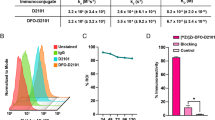Abstract
Our search for an angiogenesis-inducing factor in culture medium conditioned by human colon adenocarcinoma cells (HT-29) was inspired by the 'organizer' hypothesis originally postulated by Spemann. It led us to the isolation of angiogenin, a 14 kD protein homologous to pancreatic ribonuclease and one of the most potent stimulators of blood vessel formation known. This review summarizes the properties of angiogenin, its enzymatic and three-dimensional relationship to ribonuclease A (RNase A), those aspects of its structure that are critical for its biological function, and the therapeutic potential of angiogenin inhibition. Despite having the same arrangement of catalytic residues as RNase A, angiogenin has very low enzymatic activity. It lacks one of the four disulphide loops of RNase A; instead, the corresponding residues form part of a cell binding region. Both the catalytic activity and cell binding site are essential for angiogenesis. Angiogenin binds to cell-surface actin in confluent endothelial cells and to an as yet uncharacterized receptor on proliferating cells. Internalization and translocation to the nucleolus are also required for activity. Inhibitors of angiogenin can block angiogenesis in vitro and prevent tumour growth in vivo. Thus, a noncytotoxic neutralizing monoclonal antibody prevents the establishment of HT-29 human tumour xenografts in up to 65% of treated athymic mice. In those tumours that develop, the number of vascular elements is reduced. Actin also prevents the establishment of tumours while exhibiting no toxic effects at daily doses > 50 times the molar amount of circulating mouse angiogenin. These antagonists also inhibit the appearance of tumours derived from two other human tumour cell lines. Inhibition of the action of angiogenin may prove to be an effective therapeutic approach for the treatment of malignant disease.
Similar content being viewed by others
Author information
Authors and Affiliations
Rights and permissions
About this article
Cite this article
Vallee, B., Riordan, J. Organogenesis and angiogenin. CMLS, Cell. mol. life sci. 53, 803–815 (1997). https://doi.org/10.1007/s000180050101
Published:
Issue Date:
DOI: https://doi.org/10.1007/s000180050101




